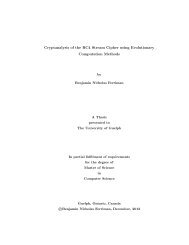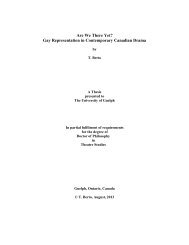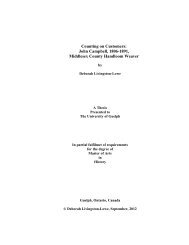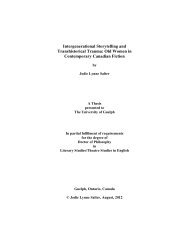THESIS - ROC CH ... - FINAL - resubmission.pdf - University of Guelph
THESIS - ROC CH ... - FINAL - resubmission.pdf - University of Guelph
THESIS - ROC CH ... - FINAL - resubmission.pdf - University of Guelph
Create successful ePaper yourself
Turn your PDF publications into a flip-book with our unique Google optimized e-Paper software.
zones are synonymous to feeding, transition, and metering for single screw polymer extrusion.<br />
Feeding is where raw materials are introduced into the barrel and slightly compressed with the<br />
expelling <strong>of</strong> air. As the materials are conveyed to the kneading zone, screw flights are filled<br />
leading to higher compression that increases pressure, temperature, and material density. The<br />
heating zone is the final section before the melt exits the extruder. The highest temperatures,<br />
shear rates, and pressures are achieved in this zone yielding the final product characteristics<br />
(Hauck and Huber 1989). Process variables include screw speed, screw configuration, barrel<br />
temperatures, and die configuration. Response variables include product temperature,<br />
residence time, torque, specific mechanical energy input, and pressure at the die. The typical<br />
target variables for film are mechanical, barrier, and color properties (Hernandez-Izquierdo and<br />
Krochta 2008). Since proteins are inherently hydrophilic, moisture content <strong>of</strong> film, which is<br />
dependent on relative humidity, is also an important variable.<br />
To allow for the extrusion <strong>of</strong> proteins, their viscoelastic behavior needs to be modified<br />
and controlled to facilitate material flow. Within the extruder, this is dictated by thermal and<br />
mechanical denaturation whereby a balance between aggregation and de-aggregation needs to<br />
be controlled (Pommet et al. 2005; Redl et al. 2003; Redl et al. 1999b). Insufficient heating<br />
would not unfold soy protein into melt deterring flow and chain alignment during extrusion.<br />
Excessive heating will cause premature aggregation from chemical cross-links, increasing melt<br />
viscosity and disrupting extrudate structure (Verbeek and van den Berg 2010). Increased<br />
network formations from heating are thought to be caused by an increase <strong>of</strong> polymer chain<br />
associations from hydrophobic interactions and the formation <strong>of</strong> disulfide bonds (Prudencio-<br />
Ferreira and Areas 1993; Redl et al. 1999b; Rouilly et al. 2006; Toufeili et al. 2002). As such,<br />
temperatures must be controlled above glass transition (Tg) but below degradation temperature<br />
to allow unfolding and ease processing. Morales and Kokini (1997) studied the glass transition<br />
<strong>of</strong> soy protein as a function <strong>of</strong> moisture content. They found the Tg <strong>of</strong> the 7S fraction ranged<br />
7

















